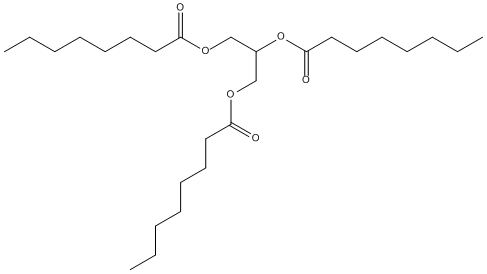Trioctanoin
General
Type : Acyl-Glycerol || Octanoate || Triacylglycerol || Fatty acid ester || Water-insoluble medium and long chain ester
Chemical_Nomenclature : 2,3-di(octanoyloxy)propyl octanoate
Canonical SMILES : CCCCCCCC(=O)OCC(COC(=O)CCCCCCC)OC(=O)CCCCCCC
InChI : InChI=1S\/C27H50O6\/c1-4-7-10-13-16-19-25(28)31-22-24(33-27(30)21-18-15-12-9-6-3)23-32-26(29)20-17-14-11-8-5-2\/h24H,4-23H2,1-3H3
InChIKey : VLPFTAMPNXLGLX-UHFFFAOYSA-N
Other name(s) : C8-triglyceride, Tricaprylin, Trioctanoin, Glycerol tricaprylate, Octanoin, tri-, Trioctanoylglycerol, Caprylin, Maceight, Glycerol trioctanoate, Glyceryl trioctanoate, Rato, Glyceryl tricaprylate, Tricaprilin, Trioctanoin oil, Tricaprylic glyceride, Caprylic acid triglyceride, Octanoic acid triglyceride, Panacete 800, Octanoic acid, 1,2,3-propanetriyl ester, Sefsol 800, Propane-1,2,3-triyl trioctanoate, 1,2,3-Tri-n-octanoylglycerol, 1,2,3-Propanetriol trioctanoate, NSC 4059, EINECS 208-686-5, Tricaprilin (JAN), Tricaprilin [JAN], BRN 1717202, NCGC00091285-01, Caprylic acid, 1,2,3-propanetriyl ester, ST51037450, DSSTox_CID_1375, 1,2,3-Trioctanoylglycerol, 1,2,3-Tricapryloylglycerol, DSSTox_RID_76119, DSSTox_GSID_21375, CAS-538-23-8, Tri-octanoin, Tri-n-octanoin, Glycerol Tri-n-octanoate, Glycerol trioctanoic acid, Octanoin, tri- (8CI), MLS002454452, 91040_ALDRICH, T9126_SIGMA, AC1L1W35, CHEMBL1406148, 91040_FLUKA, HMDB11187, NSC4059, HMS3039H17, NSC-4059, 2,3-di(octanoyloxy)propyl octanoate, Tox21_111110, Tox21_201480, Tox21_302762, ANW-42078, UNII-6P92858988, Octanoic acid,2,3-propanetriyl ester, AKOS015899778, LS-1333, NCGC00091285-02, NCGC00256431-01, NCGC00259031-01, SMR001372028, T0365, C13044, D01587, 2-octanoyloxy-1-(octanoyloxymethyl)ethyl octanoate, 4-02-00-00991 (Beilstein Handbook Reference), TG(8:0\/8:0\/8:0), I14-11558, Octanoic acid, 1,1',1''-(1,2,3-propanetriyl) ester

Target
References (9)
| Title : Characterization of LipN (Rv2970c) of Mycobacterium Tuberculosis H37Rv and its Probable Role in Xenobiotic Degradation - Jadeja_2016_J.Cell.Biochem_117_390 |
| Author(s) : Jadeja D , Dogra N , Arya S , Singh G , Kaur J |
| Ref : Journal of Cellular Biochemistry , 117 :390 , 2016 |
| Abstract : Jadeja_2016_J.Cell.Biochem_117_390 |
| ESTHER : Jadeja_2016_J.Cell.Biochem_117_390 |
| PubMedSearch : Jadeja_2016_J.Cell.Biochem_117_390 |
| PubMedID: 26212120 |
| Gene_locus related to this paper: myctu-Rv2970c |
| Title : The beta5-Loop and Lid Domain Contribute to the Substrate Specificity of Pancreatic Lipase-related Protein 2 (PNLIPRP2) - Xiao_2015_J.Biol.Chem_290_28847 |
| Author(s) : Xiao X , Lowe ME |
| Ref : Journal of Biological Chemistry , 290 :28847 , 2015 |
| Abstract : Xiao_2015_J.Biol.Chem_290_28847 |
| ESTHER : Xiao_2015_J.Biol.Chem_290_28847 |
| PubMedSearch : Xiao_2015_J.Biol.Chem_290_28847 |
| PubMedID: 26494624 |
| Gene_locus related to this paper: human-PNLIP , human-PNLIPRP2 |
| Title : Structure of human pancreatic lipase-related protein 2 with the lid in an open conformation - Eydoux_2008_Biochemistry_47_9553 |
| Author(s) : Eydoux C , Spinelli S , Davis TL , Walker JR , Seitova A , Dhe-Paganon S , de Caro A , Cambillau C , Carriere F |
| Ref : Biochemistry , 47 :9553 , 2008 |
| Abstract : Eydoux_2008_Biochemistry_47_9553 |
| ESTHER : Eydoux_2008_Biochemistry_47_9553 |
| PubMedSearch : Eydoux_2008_Biochemistry_47_9553 |
| PubMedID: 18702514 |
| Gene_locus related to this paper: human-PNLIPRP2 |
| Title : Optimization of a thermostable lipase from Bacillus stearothermophilus P1: overexpression, purification, and characterization - Sinchaikul_2001_Protein.Expr.Purif_22_388 |
| Author(s) : Sinchaikul S , Sookkheo B , Phutrakul S , Pan FM , Chen ST |
| Ref : Protein Expr Purif , 22 :388 , 2001 |
| Abstract : Sinchaikul_2001_Protein.Expr.Purif_22_388 |
| ESTHER : Sinchaikul_2001_Protein.Expr.Purif_22_388 |
| PubMedSearch : Sinchaikul_2001_Protein.Expr.Purif_22_388 |
| PubMedID: 11483000 |
| Gene_locus related to this paper: geost-lipas |
| Title : A novel extracellular esterase from Bacillus subtilis and its conversion to a monoacylglycerol hydrolase - Eggert_2000_Eur.J.Biochem_267_6459 |
| Author(s) : Eggert T , Pencreac'h G , Douchet I , Verger R , Jaeger KE |
| Ref : European Journal of Biochemistry , 267 :6459 , 2000 |
| Abstract : Eggert_2000_Eur.J.Biochem_267_6459 |
| ESTHER : Eggert_2000_Eur.J.Biochem_267_6459 |
| PubMedSearch : Eggert_2000_Eur.J.Biochem_267_6459 |
| PubMedID: 11029590 |
| Gene_locus related to this paper: bacsu-LIPB |
| Title : Purification and biochemical characterization of dog gastric lipase - Carriere_1991_Eur.J.Biochem_202_75 |
| Author(s) : Carriere F , Moreau H , Raphel V , Laugier R , Benicourt C , Junien JL , Verger R |
| Ref : European Journal of Biochemistry , 202 :75 , 1991 |
| Abstract : Carriere_1991_Eur.J.Biochem_202_75 |
| ESTHER : Carriere_1991_Eur.J.Biochem_202_75 |
| PubMedSearch : Carriere_1991_Eur.J.Biochem_202_75 |
| PubMedID: 1935982 |
| Gene_locus related to this paper: canfa-1lipg |
| Title : Purification, characterization and kinetic properties of the rabbit gastric lipase - Moreau_1988_Biochim.Biophys.Acta_960_286 |
| Author(s) : Moreau H , Gargouri Y , Lecat D , Junien JL , Verger R |
| Ref : Biochimica & Biophysica Acta , 960 :286 , 1988 |
| Abstract : Moreau_1988_Biochim.Biophys.Acta_960_286 |
| ESTHER : Moreau_1988_Biochim.Biophys.Acta_960_286 |
| PubMedSearch : Moreau_1988_Biochim.Biophys.Acta_960_286 |
| PubMedID: 3382677 |
| Title : Kinetic assay of human gastric lipase on short- and long-chain triacylglycerol emulsions - Gargouri_1986_Gastroenterology_91_919 |
| Author(s) : Gargouri Y , Pieroni G , Riviere C , Sauniere JF , Lowe PA , Sarda L , Verger R |
| Ref : Gastroenterology , 91 :919 , 1986 |
| Abstract : Gargouri_1986_Gastroenterology_91_919 |
| ESTHER : Gargouri_1986_Gastroenterology_91_919 |
| PubMedSearch : Gargouri_1986_Gastroenterology_91_919 |
| PubMedID: 3743968 |